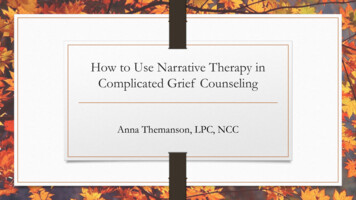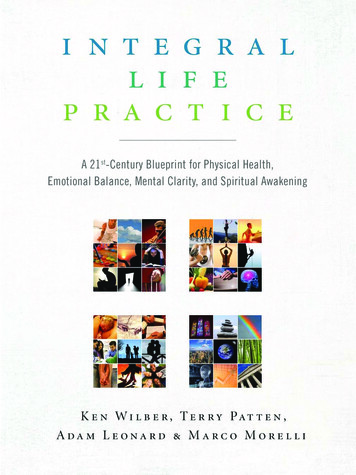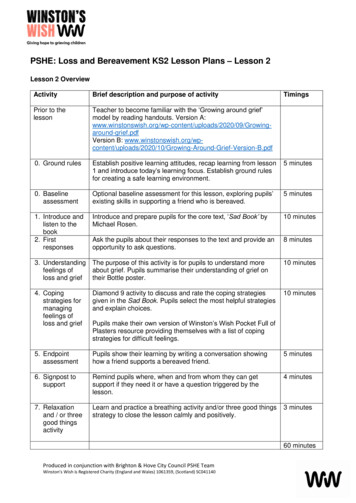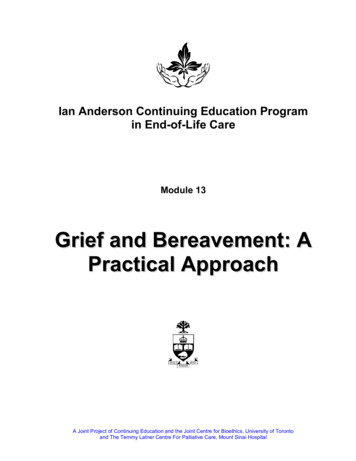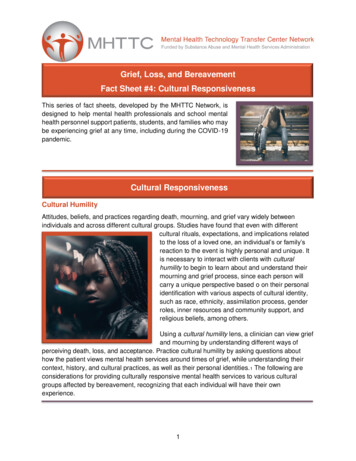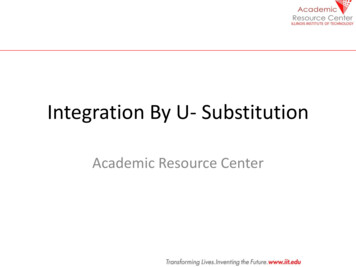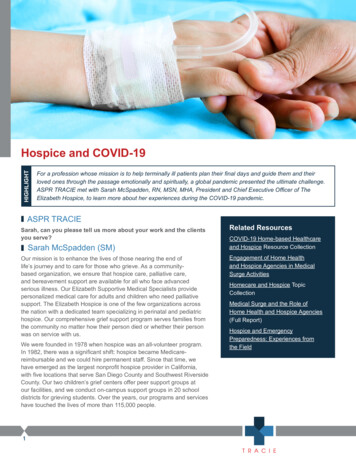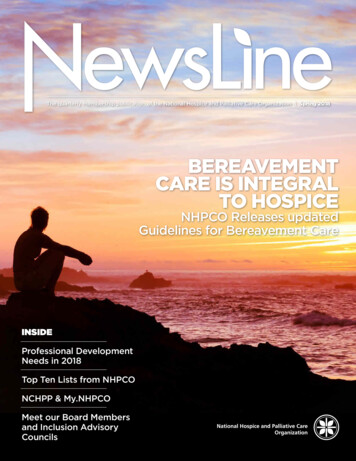
Transcription
The quarterly membership publication of the National Hospice and Palliative Care Organization Spring 2018BEREAVEMENTCARE IS INTEGRALTO HOSPICENHPCO Releases updatedGuidelines for Bereavement CareINSIDEProfessional DevelopmentNeeds in 2018Top Ten Lists from NHPCONCHPP & My.NHPCOMeet our Board Membersand Inclusion AdvisoryCouncils
Table of Contents6CoverStoryGuidelines for BereavementCare in Hospice:An Invaluable Professional ResourceNHPCO has released an expanded and updated version of its publicationGuidelines for Bereavement Care in Hospice and we share one of the sections inthis edition of NewsLine. We also include a Q&A with our NCHPP BereavementSection Leader, share brief examples of innovative member programs, andprovide information about our new bereavement performance measure tool.34MeetLori BishopVP, Palliativeand AdvancedCare35More UpdatesShort Takes &Member News40DiversitySpotlight2018 DiversityAdvisoryCouncil
16Professional DevelopmentNeeds in 2018Steve Gardner shares feedback from NHPCO’sbi-annual education needs assessment that helpsinform the development of educational programsand offerings that reflect members’ needs and areasof interest.22Top Ten ListsMembers are often surprised by some of theresources and tools that are available fromNHPCO; our Top Ten Lists share materialsthat you won’t want to miss and offer a head’sup of what’s to come.30NCHPP and My.NHPCOAmanda Bow explains how our National Council of Hospice andPalliative Professionals and our member-only networking site areessential links to the provider community.Meet the Board of Directors 2018Our Board Chairs offer messages as we introduce the NHPCO and HAN board l44Hospice andCorrectionsCouncil ofStates Spotlight48News FromNationalHospiceFoundation3250News FromWe HonorVeterans
REGISTER NOW!MANAGEMENT ANDLEADERSHIP CONFERENCE&ADVOCACY INTENSIVEPRECONFERENCE: APRIL 21-22, 2018 MAIN CONFERENCE: APRIL 23-24, 2018WASHINGTON DC ADVOCACY INTENSIVE: APRIL 25, 2018
Message From EdoOne Year InWith the release of this issue of NewsLine, I’ve marked my first anniversary withNHPCO. 2017 was a whirlwind of learning and listening, meeting new friends, andsketching out our future. If 2017 was a year for education and listening, 2018 is ayear for change and action.Change is not just on the horizon–it’s already here. Accountable Care Organizations,Independence at Home, Value Based Purchasing and various other models arecompeting for patients and scarce Medicare dollars. As I traveled the country last year,I heard concern about that change. But along with that concern, I heard manycommon themes that give me hope for our collective future–a shared set of values, acommitment to the patients and families we serve, and a communal pride that we arethe absolute best at what we do. These principles–which emanate from the heart ofhospice–are what will serve as the guiding principles for action in 2018 and beyond: We are the interdisciplinary, person-centered, integrated, coordinated benefit thatMedicare has been covering for over 35 years. What is secondary and new to therest of Medicare, is central to Hospice. We do much more than provide care to individuals – we care for caregivers andcommunities as well. We must better communicate our value to our payers and partners – government,managed care, and others. Once we establish that foundation, we must energize ourselves – and ourvolunteers and caregivers – to make sure that we communicate our value tolegislative and regulatory decision makers. Having energized ourselves and communicated our value, and having establisheda solid foundation, it is time to boldly establish a more durable vehicle forproviding more care, without arbitrary rules (six months, no concurrent care), andthat is not subject to burdensome and non-productive oversight and complianceactivity. Concurrently, we will focus on pre-hospice serious illness care that is informedand motivated by the same focus on interdisciplinary, person-centered care. Thisteam-based approach has been our bedrock for over 35 years and will continue tobe at our core going forward.I’m grateful to lead NHPCO at this important time, and look forward to workingwith and for all of you in the coming years.Edo Banach, JD, President and CEOSpring 2018 NHPCO NewsLine5
GUIDELINES FOR BEREAVEMENTCARE IN HOSPICEAN INVALUABLE PROFESSIONAL RESOURCEIntroductionBereavement care is an integral component of hospice and palliative care – part of the philosophy ofcare that separates us from many other health care providers. To support the work of thoseprofessionals who are caring for people coping with grief and loss, NHPCO has published a revisedand expanded edition of its professional resource, Guidelines for Bereavement Care in Hospice.Developed with the input from the Bereavement Professionals Section of NHPCO’s National Councilof Hospice and Palliative Professionals (NCHPP), Guidelines for Bereavement Care includeinformation on assessment, scope of service, community collaboration, education and competency,an annotated bibliography, a professional competency assessment, and more.In this issue of NewsLine, we share one of the sections from the newly revised Guidelines forBereavement Care in Hospice to give providers an opportunity to review some of the content.6NHPCO NewsLine Spring 2018
Availability, Rationale and Scope of ServicesExcerpt from the Guidelines for Bereavement Care in HospiceBackground: Identifying theavailability, rationale and scope ofhospice bereavement services providedto hospice family and friends, andnon-hospice bereaved in thecommunity provides clarity, focus anddefinition for the bereavementprogram. Defining the scope ofservices provided helps hospicepatients and families know what toexpect. The hospice organization andspecific bereavement staff must clearlyunderstand their roles andresponsibilities, and bereavementprofessionals must have the necessaryknowledge and skills needed toprovide these services.address these needs and the hospicemust identify complicated griefinterventions within their scope ofservices. The goal is for all clients tolearn to recognize their grief as part of aprocess that includes learning how tointegrate the death, understanding theneed for additional support if they facecomplicated grief, and rediscoveringmeaning, purpose and fulfillment in life.The foundation of any plan of care lies inongoing risk assessment. Recent researchin loss and grief suggests those at higherrisk for complicated grief require moreintentional and skilled follow-up (Centerfor the Advancement of Health, 2003).Accurate and ongoing risk assessmentshelp hospice bereavement professionalsGuidelines: Grief is a normal humanprocess of adjusting to changes and loss(Stroebe, Hansson, Schut & Strobe,2008; Worden, 2009). Individuals orfamilies who are experiencinguncomplicated bereavement mayrequest basic education about thenature of their experience and seeksupport to manage their lives throughthe many changes that accompany loss.offer the most appropriate service basedon identified needs. Hospicebereavement programs are not expectedto operate as mental health agencies inphilosophy or function, but they areIt is the responsibility ofthe hospice bereavementprogram to assess forcomplicated grief andpotential suicidal risk.expected to encourage bereaved familyand friends to have access tobereavement services. Hospicebereavement programs are preventativemodels of care. They facilitate healthygrieving and thereby aim to prevent theA percentage of survivors willdevelopment of grief-related health andexperience complicated grief. Thesemental health problems. Most hospiceindividuals generally have a morebereavement programs are not equippedcomplex bereavement experience withto provide psychotherapeuticsignificant difficulties that require aintervention and treatment for mentalhigher level of intervention for a longerhealth disorders. Psychotherapy may beperiod of time to enable them toindicated when individuals havedevelop or activate coping skills suitablepreexisting personality, emotional orto their needs. It is the responsibility ofdevelopmental issues that preclude thethe hospice bereavement program toability to focus on the tasks of mourningassess for complicated grief andthat are usually addressed in griefpotential suicidal risk. Hospicecounseling. This level of treatment is notbereavement professionals must haverequired by the Medicare Conditions ofthe necessary mental health andParticipation (CoP).bereavement expertise to assess andSpring 2018 NHPCO NewsLine7
continued from previous pageHospice bereavement programs are expected to providethe program is accountable for implementing andsophisticated grief support and education to their hospicecoordinating the hospice bereavement program, as directedfamilies for a minimum of thirteen months following aby such policies and procedures.patient’s death. This conveys availability of support as thebereaved individual anticipates the one year anniversary ofthe date of death, and recognizes that people are usually inScope of Hospice Bereavement Services: an emotionally different place by the 14th month after theloss. Bereavement support is accomplished through acombination of measures that includes providing supportgroups and memorial services, informational and educationalresources, counseling, and referrals to appropriatetherapeutic and community resources. Hospices should develop personalized plans of care with bereaved clientsthat detail frequency as well as scope of services provided.In addition to addressing the needs of bereaved individuals,hospice bereavement programs should identify and define the responsibilities they assume with respect to theircommunity’s loss and grief needs while never sacrificing theneeds of hospice family members. Services differ markedlyfrom program to program based upon community need andavailable resources. It is imperative, however, that hospicestaff have the requisite knowledge and skills needed toprovide or refer appropriate services to community bereaved.The Medicare Conditions of Participation includebereavement counseling to residents and employees ofSkilled Nursing Facilities/Nursing Facilities, IntermediateCare Facilities for cognitively impaired or developmentallydelayed individuals, or other facilities when appropriate andidentified in the bereavement plan of care. (Department of Health and Human Services, 42 CFR Part 418 Medicare andMedicaid Programs: Hospice Conditions of Participation;Final Rule, 418.112). Visiting a hospice patient’s roommatewho is affected by a death, providing a support session forstaff affected by several deaths in a short period of time, orsimply following up with facility staff after the death of along time resident are examples of ways hospicebereavement professionals should be providingbereavement counseling services to residents andemployees of healthcare facilities.It is important that hospices create bereavement-specificguidelines that detail the availability and scope of servicesand clearly delineate policies and procedures. Thebereavement staff person with responsibility for directing8NHPCO NewsLine Spring 2018 Identify family members in need of bereavementsupport, prior to and following the death of thepatient, including:– children in the home– caregivers– other friends or family membersAssess patient and family strengths, bereavementrisk, concerns and needs related to grief and lossfrom start of hospice care through the end ofbereavement careProvide basic grief information and supportthrough:– written materials (e.g., supportive letters,newsletters, articles)– audiovisual educational resources– individual contacts (e.g., phone calls or visits)– support groups– commemorative activities such as memorialservices– counseling sessions with a bereavement counselor– social events– collaborative work with the bereaved individual’sprimary mental health or healthcare practitionerEmpower families to recognize and develop skills tomanage grief by exploring ways they have effectivelycoped in the past and identifying areas of strengthand resilience, assisting families in identifying currentsocial and spiritual resources for support.Refer family members who need services forcomplicated bereavement, mental health or otherneeds that are outside the scope of the hospicebereavement program to quality resources in thecommunity. These might include the bereaved whorequire intervention for difficulties other than thedeath, such as substance abuse, significant mentalhealth or financial concerns.
Variations in Care: Hospice programs differ in the: Human and administrative resources available to provide bereavementservicesMethods used to track, manage, and report bereavement program activitiesLength of their follow-up care (programs range from 12 to 24 months)Additional services offered beyond those listed above (e.g., grief camps,retreats, lending libraries, special events, grief therapy, educational trainings,and crisis response)Note that the regulatory requirements from the Medicare Conditions of Participationspecify bereavement services must be offered ‘up to one year’ after the death of thepatient and the NHPCO Standards suggest a 13-month time frame.Regulatory Requirements:Medicare COP: §418.64(d)(1): Bereavement counseling. The hospice must:(i.) Have an organized program for the provision of bereavement services furnishedunder the supervision of a qualified professional with experience or education ingrief or loss counseling.(ii.) Make bereavement services available to the family and other individuals in thebereavement plan of care up to 1 year following the death of the patient.Bereavement counseling also extends to residents of a SNF/NF or ICF/MR whenappropriate and identified in the bereavement plan of care.It is important that hospicescreate bereavement-specificguidelines that detail theavailability and scope ofservices and clearly delineatepolicies and procedures.(iii.) Ensure that bereavement services reflect the needs of the bereaved.(iv.) Develop a bereavement plan of care that notes the kind of bereavementservices to be offered and the frequency of service delivery. A special coverageprovision for bereavement counseling is specified in §418.204(c).Spring 2018 NHPCO NewsLine9
continued from previous pageAcknowledgmentsQ & A with the NCHPPSection LeaderGuidelines for Bereavement Care in Hospice was created bythe Bereavement Professionals Section of NHPCO’sNational Council of Hospice and Palliative Professionals.The National Hospice and Palliative Care Organizationgratefully acknowledges the following individuals andorganizations for their contribution to this valuable resource.Diane Snyder Cowan, MA, MT-BC, CHPCANCHPP Bereavement Professional Section Leader, HospiceDiane Snyder Cowan, MA, MT-BC, CHPCA is the NCHPPBereavement Professionals Section Leader and wasinstrumental in the development of the Guidelines.NewsLine had the opportunity to ask Diane a fewquestions for some for additional insight regarding therevised and expanded publication.Q: The new resource Guidelines for Bereavement Care inof the Western Reserve, Inc., Cleveland, OHHospice seems far more comprehensive than theRex Allen, MAon revising this document?Providence Hospice of Seattle, Seattle, WAPatti Anewalt, PhD, LPC, FTPathways Center for Grief & Loss, Hospice & CommunityCare, Mount Joy, PAprevious edition. Was this intentional as you workedYes, we tried to cover all areas related to hospice andbereavement. We utilized a crosswalk that comparedtopics covered in other sections, reviewed what we feltwas missing and included references to the MedicareRobin Fiorelli, MSW, LCSWCOPs and NHCPO standards of care.VITAS Hospice, San Diego, CAQ: How long did the group of professionals who wroteChelsea Johnson, MS, MT-BC, LMTthe new Guidelines work on this project?Trustbridge, Inc., West Palm Beach, FLAlmost two years. We were small but mighty group. WeSarah Layton, MSW, LCSWdivided up areas to work on independently but thenHeartland Home Health Care and Hospice,reviewed each other’s work and edited the projectSt. Louis, MOcollectively. We also had wonderful help from NHPCO staff.Daniel A. Speis, MSW, LICSWQ: Throughout the collaboration process, are thereHospice of the Panhandle, Martinsburg, WVthings that each of you working on the projectWesley Sturgis, LCSWcoming to consensus on a difficult aspect of care?Novant Health Hospice & Palliative Care, Charlotte, NCNHPCO Staff Who ReviewedThese GuidelinesKristi DudashSenior Manager, Research and QualityAndrew Duncan, MAVice President, Membershiplearned or areas that challenged you all in terms ofOne of the challenges was verbiage. Do we use bereaved,grieving, loved one, etc.? One difficult aspect of care wascomplicated grief which is in and of itself a complex issue.It wasn’t so much of a challenge in coming to consensusas to best practice, it was more about finding the rightwords to say what we wanted to say.Q: The Annotated Bibliography and Resources is quitecomprehensive. As a professional in the field, do youJennifer Kennedy, MA, BSN, CLNCthink it’s important to continually read newSenior Director, Regulatory and Qualitypublications and access online resources?Life-long learning is critical in the world of grief andPrinter-Friendly PDF10NHPCO NewsLine Spring 2018bereavement. There have been additions and changes inthoughts about grief work, theories and approaches. While
the “evergreen” books still hold weight today, we need to keep current with importantadvances and innovations to best meet the ever changing communities we serve.Q: We know that many hospice programs are facing tightening budgets and limitedresources, is there advice you might give a program that if facing such constraints?It’s important to know what other resources are available in the community from otherhospices, faith communities, mental health agencies, funeral homes, etc. Avoidduplication of programs and offer services that are not only unique but fulfil a need.Know where to refer folks who fall outside your agency’s scope of services.Q: There seem to be many things happening in the world around us that couldbenefit from the skills of a hospice bereavement professional; are there wayshospices can engage with communities apart from traditional care patients andfamily caregivers? Are there things a hospice should be cautious about in termsof reaching out to the community?Absolutely. Hospices can work with local media reporting on community grief issuessuch as natural disasters, school shootings and the opioid crisis. Hospices can providegrief education seminars, offer hand-outs and other literature on grief topics. Someagencies offer grief counseling to community clients. Others provide death-related crisisresponse. Loss specific grief support groups, school based programs and consultationare also ways to get involved. Bereavement professionals need to know their skill leveland have training in providing any specialized community grief support. Agencies mayhave limited resources.It’s important to knowwhat other resourcesare available in thecommunity fromother hospices, faithcommunities, mentalhealth agencies, funeralQ: Is there additional advice you would like to offer for someone who might be anew bereavement professional working in the field?homes, etc.Become engaged with NCHPP, sign up for My.nhpco.org. Join the chats – especially the“new to bereavement” chat. Post questions on the discussion threads. There is a breadthand depth of wisdom and expertise out there and we can all learn from one another. (Seepage 30 to learn more about NCHPP, My.NHPCO and the many benefits for members.)Q: Any additional thoughts to share?One thing to remember is that the guidelines are suggestions. They are notrequirements by any governing bodies. Sometimes, professionals are looking for cutand dry answers about caseloads, visit frequencies, etc. The guidelines providesuggestions for best practices and what to consider, but ultimately it is an agency’sdecision to determine what their bereavement program can and will look like.Spring 2018 NHPCO NewsLine11
continued from previous pageExamples of Bereavement OfferingsIn response to a request forI am now without the Center forinformation from the BereavementHospice Care’s caring, professional,Professionals group on My.NHPCO,kind influence.”NewsLine shares some examples ofbereavement programs that reflectthe creativity and range of servicesHalcyon Hospice andPalliative Care, Coloradoavailable from hospice programsYoga for Griefacross the country.Yoga is the union of breath withAseraCare Hospice,across the U.S.gradual and intentional movementand teaches us safe and approachableways to connect and listen to ourA Butterfly to Rememberbodies. This yoga therapy group isThese events offer an opportunity formade up of a series of 90-minutefriends, family and communityrestorative classes that incorporatemembers to remember and honor thebreathing exercises with gentle poseslegacy of those who have died withto bring peace and calm to the bodythe release of butterflies, bubbles orand mind.doves. Held at AseraCare Hospiceagencies across the country, eachcelebration is unique to its location.Hospice & Community Care’sPathways Center for Grief &Loss, PennsylvaniaCasa de la Luz Hospice,ArizonaSchool Crisis Response Teams: ThreeMind-Body Skills GroupThis three day series provides theOver the course of eight sessions,basics needed for crisis teamparticipants explore different ways tomembers to feel prepared to respondcope with stress that providesto a wide range of incidents involvingeducational components as well asthe deaths of students or staff.skill building tools such as breathing,Content includes the ‘big picture’ ofmeditation, autogenic training,crisis response, developmentallybiofeedback, drawing, journaling, andspecific information and strategies todancing.address diverse needs of bereavedCenter for Hospice Care – LifeTransition Center, IndianaDay Flight Team Trainingfaculty and students of all ages. Thosetrained become part of the countyCrisis Management Flight Team andLoss After Addiction Groupare deployed to area schools asThe group is a bi-monthly educationalneeded to supplement local schools inand grief support group for adultstimes of tragedies.who have experienced the death of aloved one to drugs or alcohol abuseand/or overdose. One of the originalmembers of the group stated, “Iwould not be living the productive life12NHPCO NewsLine Spring 2018Hospice of Santa Cruz County,CaliforniaWriting through HealingPutting pen to paper is a powerfulway to explore a personal journey in amanner that is both meaningful andrich with complexity — especiallywhen talking about grief does notcome easily for a person. Creativeexercises are designed to helpparticipants grow and heal, in newand gently surprising ways.Hospice of the WesternReserve, OhioRiding through Grief: The HealingPower of HorsesThis day camp is offered incollaboration with Fieldstone FarmTherapeutic Riding Center for childrenages 8-12. Through fun horsebackriding lessons and un-mountedactivities with horses, participantsexplore grief issues. Prompted by thesuccess of the Riding through Griefcamps, this program has beenexpanded to an adult equine retreat.Infinity Hospice Care, NevadaResponse to Las Vegas ShootingFollowing the tragic shooting onOctober 1, Infinity Hospice Careresponded to offer services andsupport to first responders and thecommunity. Ongoing efforts includesupport groups for victims of thetragedy that include 911 operators andnight staff at local funeral homes.Other programs in the area have alsostepped up to help with the myriad ofcommunity needs following thisnational tragedy.
Mary Greeley Hospice, IowaCooking for OneA workshop designed to address issues that accompany a newly bereaved spouse, bothin the practical and psychosocial domains relating to mealtime. Combining the expertiseof a dietitian, executive chef, and bereavement counselor, participants will receiveeducation and support as they adjust to sitting next to an empty chair at the table.Seasons Hospice, Georgia and MichiganI would not be living theThe Widow’s WalkOffered by the Seasons Team in Georgia, bereaved spouses/partners meet at a differenttrailhead once per month on a Saturday and hike together. Along the way, theyreminisce and support one another; while at the same time getting physical exercise,which is known to be a healthy way of dealing with emotional stress.productive life I am nowwithout the Center forHospice Care’s caring,Holiday PartyHosted every December by a Chaplain at the Michigan location, the Holiday Partyconsists of a nice dinner at local event space. It is a time of fellowship, support, andsharing where strong bonds are made among group members.professional, kindinfluence.VITAS Healthcare, CaliforniaDay of the Dead EventIn the Mexican tradition, Día de los Muertos is considered the day that departed soulsreturn to Earth — so it is dedicated to remembering and honoring those that have died.Family members typically gather graveside to mourn their loved ones and to celebratetheir lives. Some of our programs recreate this event that includes building an altar,providing traditional foods and even making sugar skulls.Printer-Friendly PDFGuidelines for BereavementCare in HospiceGUIDELINES FOR BEREAVEMENTCARE IN HOSPICEBrand New! These guidelines serve to promote theprovision of effective bereavement services and advance thepractice of quality hospice and community bereavement care.The guidelines cover essential components of a hospicebereavement program providing information on how foster aprogram that goes beyond the baseline services required bystate and federal regulations.Order online from NHPCO’s Marketplaceor call 1-800-646-6460.PROFESSIONAL DEVELOPMENT AND RESOURCE SERIESSpring 2018 NHPCO NewsLine13
NHF Receives Grantfrom LGA to Create“Find a BereavementProvider” ToolLegal & General America has awardedFrom FEBS to EGSSEvaluating Hospice Bereavement Servicesa 25,000 grant to the NationalHospice Foundation for the creation ofan online resource to help the publicNHPCO is committed to providinga) are intended to match the bereavedhospices with the means to receiveperson’s need for support, whilefind information and communityfeedback and compare theirrecognizing that not all individualssupport services addressing grief andperformance to national data as awill have the same needs; andbereavement.mechanism for ensuring quality ofcare. An important part of that processis the development of performancemeasures that provide useful,meaningful, and actionable data.The Family Evaluation of BereavementServices (FEBS) survey was developedby NHPCO in collaboration with theb) have the goal of assisting theLGA will work with staff at NHPCO tobereaved person to manage thecreate an online searchable databaseimpact of loss.that will offer resources such asThe survey design also takes intoaccount that hospices offer servicesbased on their particular preferencesand resources, and that this, in turn,individual counseling, group supportand workshop activities designed tohelp individuals struggling with griefand loss.creates wide variation in the numberIn addition to the online “find aand nature of bereavement servicesprovider” tool, the grant will support aoffered by hospices. The surveyconsumer outreach and educationincludes questions on a wide range ofinitiative. NHPCO believes thatservices, many of them optional so thateveryone should have access tohospices may tailor the EGSS survey tosupport whenever faced with seriousreflect the specific services they offer.loss, grief and bereavement.of NCHPP bereavement professionals,Because the quality of a bereavementOur online database will allow a personNHPCO revised the survey in 2017 andprogram cannot be evaluated based onto search from any device anywherebegan implementation of the newwhere its clients are in the grievingand locate and contact bereavementsurvey in 2018. That revision wasprocess, the survey does not include anprofessionals offering counselingaccompanied by a change in the nameassessment of respondents’ progress.services, group support, specialof the survey to Evaluation of GriefWhile grief assessment may be usefulservices (activities specific for childrenSupport Services (EGSS).for bereavement staff in screening andand teens or bereaved who have lost aplanning interventions for individualspouse, a child, etc).National Council of Hospice andPalliative Professionals BereavementProfessionals Section as a means forhospices to evaluate and improve thequality of their bereavement services in2007. With feedback from FEBS usersand guidance from an advisory groupNHPCO continues to provide onlinedata submission and comparativereporting of survey results for hospicesto use in their quality assessment andperformance improvement efforts.clients, individual grief assessment haslittle utility in reporting and interpretingcomparative program evaluation dataat the national level. A screeningquestion has been included, however,The EGSS survey is designed toto identify persons who may needevaluate bereavement services from theadditional follow-up and assistance.perspective of the recipients of theservices. The survey is based on theassumptions that bereavement services:NHPCO is eager for member hospiceprograms to implement EGSS duringthe first quarter of 2018. For moreinformation and to access the survey,visit the EGGSS page at nhpco.org/egss.14NHPCO NewsLine Spring 2018In 2017, LGA awarded NHF a grant tocreate an educational videohighlighting the importance of advancecare planning. The video, “AdvanceCare Planning,” was released last year.
NHPCO ResourcesHOSPICE VOLUNTEERNHPCO’S 2016 NATIONALPROGRAM RESOURCESTAR REPORT (PDF ONLY)MANUALThe Surve
must identify complicated grief interventions within their scope of services. The goal is for all clients to learn to recognize their grief as part of a process that includes learning how to integrate the death, understanding the need for additional support if they face complicated grief, an
